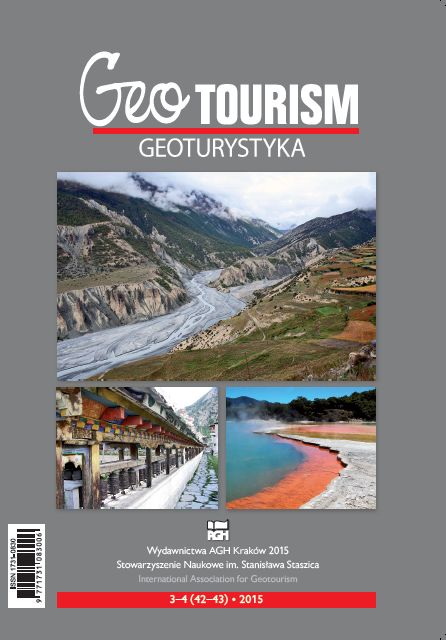Geothermal fields of New Zealand in tourism industry–the case of complementary assets and competitive products // Obszary geotermalne Nowej Zelandii jako obiekty turystyczne–przykład komplementarności tematycznej i konkurencyjności produktu turystycznego
DOI:
https://doi.org/10.7494/geotour.2015.42-43.3Słowa kluczowe:
geothermal phenomena, interpretation, volcanic tourism, tourist product, tourism infrastructure, New Zealand // zjawiska geotermalne, interpretacja, turystyka wulkaniczna, produkt turystyczny, zagospodarowanie turystyczne, Nowa ZelandiaAbstrakt
Geothermal phenomena in the North Island of New Zealand have been a basis of tourism industry since the mid-19th century. Their highlights include geysers, hot springs, mud pools, steam vents, craters, and various silica deposition features. Five geothermal sites, Te Puia Whakarewarewa, Waimangu, Wai-O-Tapu, Orakei Korako, and Craters of the Moon, are subjects of this study which is focused on interrelated issues of diversity, accessibility, and interpretation. The sites are sufficiently different in terms of natural phenomena to be perceived as complementary, offering jointly a comprehensive picture of geothermal phenomena. However, cooperation between their properties hardly exists. In promotion, unusual scenic values and record features are emphasized, whereas more in-depth interpretation is limited. There are opportunities to enhance educational components of each site, so that they can offer experience and learning rather than experience only and become fully developed geotourist destinations. //
Zjawiska geotermalne na Wyspie Północnej w Nowej Zelandii były podstawą rozwoju turystyki na tym obszarze już od połowy XIX w. Szczególnym zainteresowaniem cieszyły się gejzery, gorące źródła, sadzawki błotne, fumarole i różnego rodzaju formy depozycyjne krzemionki. Do analizy form udostępniania dla zwiedzających oraz zagospodarowania pod kątem edukacyjnym wybrano pięć popularnych miejsc geotermalnych: Te Puia Whakarewarewa, Waimangu, Wai-O-Tapu, Orakei Korako i Craters of the Moon. Miejsca te są znacząco zróżnicowane pod względem przyrodniczym i w sposób komplementarny przedstawiają pełen obraz zjawisk geotermalnych, jednak pomiędzy tymi obiektami, zarządzanymi przez różne przedsiębiorstwa, praktyczne nie ma współpracy. W promocji podkreślane są głównie walory estetyczne tychmiejsc, natomiast brakuje pogłębionej interpretacji prezentowanych zjawisk. Aby opisywane miejsca mogły oprócz przeżyć natury estetycznej dostarczać walorów edukacyjnych, a więc w pełni spełniać kryteria atrakcji geoturystycznych, niezbędne jest rozszerzenie oferty umożliwiającej interpretację zjawisk geotermalnych.
Pobrania
Bibliografia
Andrews P., 1995. Tarawera and the Terraces. Arrow Press, Morrinsville.
Armiero V., Petrosino P., Lirer L., Alberico I., 2011. The GeoCaF project: proposal of a geosites network at Campi Flegrei (Southern Italy). Geoheritage, 3: 195–219.
Browne P.R.L., Lawless J.V., 2001. Characteristics of hydrothermal eruptions, with examples from New Zealand and elsewhere. Earth-Science Reviews, 5: 299–331.
Cody A.D., Lumb J.T., 1992. Changes in thermal activity in the Rotorua geothermal field. Geothermics, 21: 215–230.
Dowling R.K., 2011. Geotourism’s global growth. Geoheritage, 3: 1–13.
Conly G., 1985. Tarawera. The Destruction of the Pink and White Terraces. Grantham House, Wellington. Dowling R.K., 2011. Geotourism’s global growth. Geoheritage, 3: 1–13.
Ell G., 1986. Discover New Zealand: Volcanic Places. The Bush Press, Auckland.
Ell G., 1995. Rotorua. Past and Present. The Bush Press, Auckland.
Erfurt-Cooper P., 2010. Introduction. In: Erfurt-Cooper P., Cooper M. (eds), Volcano and geothermal tourism: Sustainable geo-resources for leisure and recreation. Earthscan, London: 3–31.
Erfurt-Cooper P., 2011. Geotourism in volcanic and geothermal environments: playing with fire? Geoheritage, 3: 187–193.
Erfurt-Cooper P. (ed.), 2014. Volcanic Tourist Destinations. Springer, Heidelberg.
Grant C., 2010. Towards a typology of visitors to geosites. Paper presented at the Second Global Geotourism Conference, Making Unique Landforms Understandable. Mulu, Sarawak, Malaysia, 17–20 April (cited after Dowling, 2011).
Hall C.M., Kearsley G.W., 2001. Tourism in New Zealand: an introduction. Oxford University Press, Melbourne.
Hall C.M., Lew A.A., 2009. Understanding and managing tourism impact. An integrated approach. Routledge, London – New York.
Houghton B., Scott B., 2008. Geyserland. A guide to the volcanoes and geothermal areas of Rotorua. Geological Society of New Zealand, Guidebook No. 13.
Hose T.A., 1995. Selling the story of Britain’s stone. Environmental Interpretation, 10(2): 16–17.
Hunt T.M., Glover R.B., Wood C.P., 1994. Waimangu, Waiotapu, and Waikite geothermal systems, New Zealand: background and history. Geothermics, 23: 379–400.
Latocha A., 2006. Atrakcje geoturystyczne Nowej Zelandii. Geoturystyka, 3 (6): 3–14.
Lloyd E.T., 1959. The hot springs and hydrothermal eruptions of Waiotapu. New Zealand Journal of Geology and Geophysics, 2: 141–176.
Lloyd E.T., 1972. Geology and Hot Springs of Orakeikorako. New Zealand Geological Survey Bulletin, 85.
Lloyd E.T., 1975. Geology of Whakarewarewa hot springs. NZ Department of Scientific and Industrial Research, Information Series, No. 11.
McClure M., 2004. The Wonder Country. Making New Zealand Tourism. Auckland University Press, Auckland.
Neilson G., Bignall G., Bradshaw D., 2010. Whakarewarewa a Living Thermal Village – Rotorua, New Zealand. In: Proceedings World Geothermal Congress 2010. Bali, Indonesia, 25–29 April 2010: 1–7.
Newhall C., 2014. A dilemma for tourists and land managers alike: what risks to take? In: Erfurt-Cooper P. (ed.), Volcanic Tourist Destinations. Springer, Berlin – Heidelberg: 351–353.
Pearce D.G., Tan R., 2006. The distribution mix for tourism attractions in Rotorua, New Zealand. Journal of Travel Research, 44: 250–258.
Rodgers K.A., Hamlin K.A., Browne P.R.L., Campbell K.A., Martin R., 2000. The steam condensate alteration mineralogy of Ruatapu cave, Orakei Korako geothermal field, Taupo Volcanic Zone, New Zealand. Mineralogical Magazine, 64: 125–142.
Roscoe R., 2010. Geothermal parks in New Zealand. In: Erfurt-Cooper P., Cooper M. (eds), Volcano and geothermal tourism: Sustainable geo-resources for leisure and recreation. Earthscan, London: 324–328.
Ryan C., Pike S., 2003. Maori-based tourism in Rotorua: perception of place by domestic visitors. Journal of Sustainable Tourism, 11: 307–321.
Scott B.J., Gordon D.A., Cody A.D., 2005. Recovery of Rotorua geothermal field, New Zealand: Progress, issues and consequences. Geothermics, 34: 161–185.
Simmons S.F., Browne P.R.L., Scott B.J., 2004. Field Trip 2. Geothermal Systems. In: Geological Society of New Zealand – New Zealand Geophysical Society, 26th New Zealand Geothermal Workshop 6th – 9th December 2004. Geological Society of New Zealand Miscellaneous Publication 117B: 11–40.
Warbrick A., 1934. Adventures in Geyserland. Reed, Dunedin – Wellington.
www.tripadvisor.com



